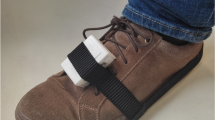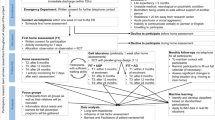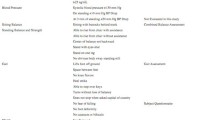Abstract
Background
Falls are among the predominant causes for morbidity and mortality in elderly persons and occur most often in geriatric clinics. Despite several studies that have identified parameters associated with elderly patients’ fall risk, prediction models – e.g., based on geriatric assessment data – are currently not used on a regular basis. Furthermore, technical aids to objectively assess mobility-associated parameters are currently not used.
Objectives
To assess group differences in clinical as well as common geriatric assessment data and sensory gait measurements between fallers and non-fallers in a geriatric sample, and to derive and compare two prediction models based on assessment data alone (model #1) and added sensory measurement data (model #2).
Methods
For a sample of n=110 geriatric in-patients (81 women, 29 men) the following fall risk-associated assessments were performed: Timed ‘Up & Go’ (TUG) test, STRATIFY score and Barthel index. During the TUG test the subjects wore a triaxial accelerometer, and sensory gait parameters were extracted from the data recorded. Group differences between fallers (n=26) and non-fallers (n=84) were compared using Student’s t-test. Two classification tree prediction models were computed and compared.
Results
Significant differences between the two groups were found for the following parameters: time to complete the TUG test, transfer item (Barthel), recent falls (STRATIFY), pelvic sway while walking and step length. Prediction model #1 (using common assessment data only) showed a sensitivity of 38.5% and a specificity of 97.6%, prediction model #2 (assessment data plus sensory gait parameters) performed with 57.7% and 100%, respectively.
Discussion and conclusion
Significant differences between fallers and non-fallers among geriatric in-patients can be detected for several assessment subscores as well as parameters recorded by simple accelerometric measurements during a common mobility test. Existing geriatric assessment data may be used for falls prediction on a regular basis. Adding sensory data improves the specificity of our test markedly.
Zusammenfassung
Hintergrund
Sturzereignisse gehören zu den wichtigsten Ursachen für Morbidität und Mortalität im fortgeschrittenen Alter und treten besonders häufig in geriatrischen Kliniken auf. Obwohl einige Studien bereits Parameter identifiziert haben, welche mit dem Sturzrisiko assoziiert sind, werden zur Zeit Prädiktionsmodelle, die z. B. auf geriatrischen Assessmentdaten basieren, nicht regelhaft verwendet. Zudem werden in der Praxis kaum technische Hilfsmittel zur objektiven Messung von mobilitätsassoziierten Bewegungsparametern eingesetzt.
Zielsetzung
Ziel war die statistische Analyse von Unterschieden zwischen zwei Gruppen stationär-geriatrischer Patienten (Gestürzte und Nichtgestürzte) in Bezug auf gebräuchliche mobilitäts- bzw. sturzassoziierte geriatrische Assessmenttests sowie sensorisch erfasste Gangparameter. Auf der Basis der Ergebnisse sollten zwei statistische Prädiktionsmodelle berechnet und hinsichtlich ihrer Aussagekraft verglichen werden. Modell 1 verwendet nur die Assessmentdaten, Modell 2 zusätzlich technisch gemessene Gangparameter.
Methoden
Bei einer Stichprobe von n=110 stationär-geriatrischen Patienten (81 weiblich, 29 männlich) wurden folgende Assessmenttests durchgeführt: Timed ‚Up & Go‘ (TUG-)Test, STRATIFY-Score und Barthel-Index. Während des TUG wurden mit einem triaxialen Beschleunigungssensor Bewegungsdaten gemessen und Gangparameter berechnet. Die Mittelwertdifferenzen der einzelnen Parameter zwischen der Gruppe der Gestürzten (n=26) und Nichtgestürzten (n=84) wurden mit dem Student-t-Test verglichen. Zusätzlich wurden aus den Daten zwei Klassifikationsmodelle abgeleitet und miteinander verglichen.
Ergebnisse
Signifikante Gruppenunterschiede wurden für folgende Parameter gefunden: benötigte Zeitdauer zur Vollendung des TUG-Tests, Transfer (Barthel-Index), Sturz in den letzten zwei Monaten (STRATIFY-Score) und Schrittlänge sowie Schwankungsbreite des Beckens beim Gehen. Das Prädiktionsmodell 1 (nur Assessmentdaten) weist eine Sensitivität von 38,5% bei einer Spezifität von 97,6% auf, Modell 2 (zusätzlich Gangparameter) zeigt eine Sensitivität von 57,7% bei einer Spezifität von 100%.
Diskussion und Ausblick
Es zeigen sich signifikante Unterschiede zwischen gestürzten und nichtgestürzten stationär-geriatrischen Patienten sowohl bei Items gebräuchlicher geriatrischer Assessmenttests als auch bei sensorisch erfassten Gangparametern. Regulär erhobene Daten könnten für eine automatisierte Einschätzung des individuellen Sturzrisikos verwendet werden, wobei die prädiktive Aussagekraft durch das Einbeziehen einfach messbarer Gangparameter deutlich gesteigert wird.
Similar content being viewed by others
References
Stevens JA, Corso PS, Finkelstein EA, Miller TR (2006) The costs of fatal and non-fatal falls among older adults. Inj Prev 12:290–295
Heinze C, Halfens RJ, Dassen T (2007) Falls in German in-patients and residents over 65 years of age. J Clin Nurs 16:495–501
Delbaere K, Van den Noortgate N, Bourgois J et al (2006) The Physical Performance Test as a predictor of frequent fallers: a prospective community-based cohort study. Clin Rehabil 20:83–90
Oliver D, Daly F, Martin FC, McMurdo ME (2004) Risk factors and risk assessment tools for falls in hospital in-patients: a systematic review. Age Ageing 33:122–130
Ruchinskas R (2003) Clinical prediction of falls in the elderly. Am J Phys Med Rehabil 82:273–278
Gerdhem P, Ringsberg KA, Akesson K, Obrant KJ (2005) Clinical history and biologic age predicted falls better than objective functional tests. J Clin Epidemiol 58:226–232
Gluck T, Wientjes HJ, Rai GS (1996) An evaluation of risk factors for in-patient falls in acute and rehabilitation elderly care wards. Gerontology 42:104–107
Oliver D, Britton M, Seed P et al (1997) Development and evaluation of evidence based risk assessment tool (STRATIFY) to predict which elderly inpatients will fall: case-control and cohort studies. BMJ 315:1049–1053
Coker E, Oliver D (2003) Evaluation of the STRATIFY falls prediction tool on a geriatric unit. Outcomes Manag 7:8–14
Borchelt M, Vogel W, Steinhagen-Thiessen E (1999) The Geriatric Minimum Data Set (Gemidas) of the Federal Association of Clinical Geriatric Facilities e. V. as an instrument for quality assurance in inpatient geriatrics. Z Gerontol Geriatr 32:11–23
Giansanti D (2006) Investigation of fall-risk using a wearable device with accelerometers and rate gyroscopes. Physiol Meas 27:1081–1090
Giansanti D, Maccioni G, Cesinaro S et al (2008) Assessment of fall-risk by means of a neural network based on parameters assessed by a wearable device during posturography. Med Eng Phys 30:367–372
Takenoshita K, Shiozawa N, Onishi J, Makikawa M (2005) Development of a portable acceleration monitor device and its clinical application for the quantitative gait assessment of the elderly. Proc Conf IEEE Eng Med Biol Soc 4:3534–2527
Kamen G, Patten C, Du CD, Sison S (1998) An accelerometry-based system for the assessment of balance and postural sway. Gerontology 44:40–45
Moe-Nilssen R, Helbostad JL (2005) Interstride trunk acceleration variability but not step width variability can differentiate between fit and frail older adults. Gait Posture 21:164–170
Podsiadlo D, Richardson S (1991) The timed Up & Go: a test of basic functional mobility for frail elderly persons. J Am Geriatr Soc 39:142–148
Mahoney FI, Barthel DW (1965) Functional evaluation: the Barthel index. Md State Med J 14:61–65
Gietzelt M, Wolf KH, Marschollek M, Haux R (2008) Automatic Self-Calibration of Born-Worn Triaxial Accelerometers for Application in Healthcare. Presented at Pervasive Health 2008, Tampere, Finland
Gietzelt M (2008) Konzeption, Implementierung und Evaluation einer Methode zur automatisierten Sturzrisikoerkennung [Diploma thesis]. Braunschweig Institute of Technology
Perry J (1992) Gait analysis: normal and pathological function. Slack, Thorofare/NJ
Hong SK, Bae J, Lee SC et al (2006) An effective method of Gait Stability Analysis using inertial sensors. In: Gelbukh A, Reyes-Garcia CA (eds) MICAI 2006: advances in artificial intelligence. Springer, Berlin Heidelberg New York, pp 1220–1228
SPSS (2007) http://www.spss.com, cited Oct 16th 2007
Breiman L, Friedman J, Stone C, Olshen RA (1984) Classification and regression trees. Chapman & Hall/CRC
Morse JM, Tylko SJ, Dixon HA (1987) Characteristics of the fall-prone patient. Gerontologist 27:516–522
Lichtenstein MJ, Griffin MR, Cornell JE et al (1994) Risk factors for hip fractures occurring in the hospital. Am J Epidemiol 140:830–838
Schmid NA (1990) 1989 Federal Nursing Service Award Winner. Reducing patient falls: a research-based comprehensive fall prevention program. Mil Med 155:202–207
Thapa PB, Brockman KG, Gideon P et al (1996) Injurious falls in nonambulatory nursing home residents: a comparative study of circumstances, incidence, and risk factors. J Am Geriatr Soc 44:273–278
Tiedemann AC, Shimada H, Sherrington C et al (2008) The comparative ability of eight functional mobility tests for predicting falls in community-dwelling older people. Age Ageing 37:430–435
Wolf KH, Lohse A, Marschollek M, Haux R (2007) Development of a fall detector and classifier based on a triaxial accelerometer demo board. In: Bajart AHM, Strang T (eds) Proc 9th International Conference on Ubiquitous Computing (UbiComp 2007), Innsbruck, pp 210–213
Marschollek M, Ludwig W, Schapiewski I et al (2007) Multimodal home monitoring of elderly people–first results from the LASS study. IEEE First International Workshop on Smart Homes for Tele-Health (SmarTel07), Niagara Falls, Canada, May 21–23
Saranummi N, Wactlar H (2008) Pervasive healthcare-selected papers from the Pervasive Healthcare 2008 Conference, Tampere, Finland. Methods Inf Med 47:175–177
Bardram JE (2008) Pervasive healthcare as a scientific discipline. Methods Inf Med 47:178–185
Conflicts of interest
The corresponding author states that there are no conflicts of interest.
Acknowledgements
The authors thank the staff of the physiotherapy department of the Braunschweig Medical Center, and especially Cornelia Kuehling, for the invaluable support in conducting the study. Furthermore, we thank Wolfram Ludwig for his support in the clinical measurements.
Author information
Authors and Affiliations
Corresponding author
Rights and permissions
About this article
Cite this article
Marschollek , M., Nemitz , G., Gietzelt , M. et al. Predicting in-patient falls in a geriatric clinic. Z Gerontol Geriat 42, 317–322 (2009). https://doi.org/10.1007/s00391-009-0035-7
Received:
Accepted:
Published:
Issue Date:
DOI: https://doi.org/10.1007/s00391-009-0035-7




